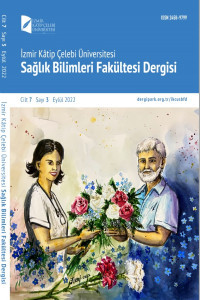Yara Kültürlerinden İzole Edilen Mikroorganizmalar ve Antibiyotik Dirençleri /1 Yıllık Süreç
Antibiyotik duyarlılığı, yara kültürü, yara yeri enfeksiyonu.
Microorganisms Which Isolated From Wound Cultures and Their Antimicrobial Susceptibilities/A Year Period
Antibiotic susceptibility, wound cultures, wound infection.,
___
- Haalboom M, Blokhuis-Arkes MHE, Beuk RJ, Meerwaldt R, Klont R, M J Schijffelen et al. Culture results from wound biopsy versus wound swab: does it matter for the assessment of wound infection? Clin Microbiol Infect. 2019;25(5):629.e7-629.e12.
- Haalboom M, Blokhuis-Arkes MHE, Beuk RJ, Klont R, Guebitz G, Heinzle A et al. Wound swab and wound biopsy yield similar culture results. Wound Repair Regen. 2018;26(2):192-9.
- Wongkietkachorn A, Surakunprapha P, Titapun A, Wongkietkachorn N, Wongkietkachorn S. Periwound Challenges Improve Patient Satisfaction in Wound Care. Plast Reconstr Surg Glob Open. 2019;7(3):e2134.
- Yurtsever SG, Kurultay N, Çeken N, Yurtsever Ş, Afşar İ, Şener G ve ark. Yara yeri örneklerinden izole edilen mikroorganizma¬lar ve antibiyotik duyarlılıklarının değerlendiril¬mesi, ANKEM Derg. 2009;23(1):34-8.
- Shettigar K, Murali TS. Virulence factors and clonal diversity of Staphylococcus aureus in colonization and wound infection with emphasis on diabetic foot İnfection. Eur J Clin Microbiol Infect Dis. 2020;39(12):2235-46.
- Bayırlı Turan D. Yara kültürleri sonuçlarının Q skorlaması ile birlikte analizi. Turk Clin Lab. 2020; 11(4):300-6.
- Sisay M, Worku T, Edessa D. Microbial epidemiology and antimicrobial resistance patterns of wound infection in Ethiopia: a meta-analysis of laboratory-based cross-sectional studies. BMC Pharmacol Toxicol. 2019; 20(1):35.
- Pondei K, Fente BG, Oladapo O. Current microbial isolates from wound swabs, their culture and sensitivity pattern at the niger delta university teaching hospital, okolobiri, Nigeria. Trop Med Health. 2013; 41(2):49-53.
- Upreti N, Rayamajhee B, Sherchan SP, Choudhari MK, Banjara MR. Prevalence of methicillin resistant Staphylococcus aureus, multidrug resistant and extended spectrum β-lactamase producing gram negative bacilli causing wound infections at a tertiary care hospital of Nepal. Antimicrob Resist Infect Control. 2018; 7: 121.
- Kassam NA, Damian DJ, Kajeguka D, Nyombi B, Kibiki GS. Spectrum and antibiogram of bacteria isolated from patients presenting with infected wounds in a Tertiary Hospital, northern Tanzania. BMC Res Notes. 2017;10(1):757.
- Collier M. Wound-bed management: key principles for practice. Prof Nurse. 2002;18(4):221-5
- Shriyan A, Sheetal R, Nayak N. Aerobic microorganism in post- operative wound infection and their antimicrobial susceptibility patterns. J Clin Diagn Res. 2010;3:2208–16.
- Etok CA, Edem EN, Ochang E. Aetiology and antimicrobial studies of surgical wound infections in University of Uyo Teaching Hospital (UUTH) Uyo, Akwa Ibom State, Nigeria. Niger Open Access Sci Rep. 2012;1:1–5.
- Cross HH. Obtaining a wound swab culture specimen. Nursing. 2014 Jul;44(7):68-9.
- Matkoski C, Sharp SE, Kiska DL. Evaluation of the Q score and Q234 systems for cost-effective and clinically relevant interpretation of wound cultures. J Clin Microbiol. 2006;44(5):1869-72.
- The European Committee on Antimicrobial Susceptibility Testing. Breakpoint tables for interpretation of MICs and zone diameters. Version 10.0, 2020. http://www.eucast.org
- Altan G, Mumcuoğlu İ, Hazırolan G, Dülger D, Aksu N. Yara örneklerinden izole edilen mikroorganizmalar ve antimikrobiyallere duyarlılıkları. Turk Hij Den Biyol Derg. 2017; 74(4):279-86.
- Daeschlein G. Antimicrobial and antiseptic strategies in wound management. Int Wound J. 2013;10 Suppl 1(Suppl 1):9-14.
- Yerlikaya H, Kirişci Ö, Çilburunoğlu M, Uğurlu H, Aral M, Muratdağı G. Yara Kültürlerinden İzole Edilen Mikroorganizmalar ve Antibiyotik Duyarlılıkları. Sakarya tıp derg. 2021;11(1):170-6.
- Bessa LJ, Fazii P, DiGiulio M, Cellini L. Bacterial isolates from infected wounds and their antibiotic susceptibility pattern: some remarks about wound infection. Int Wound J. 2015;12(1):47-52.
- Krumkamp R, Oppong K, Hogan B, Strauss R, Frickmann H, Wiafe- Akenten C et al. Spectrum of antibiotic resistant bacteria and fungi isolated from chronically infected wounds in a rural district hospital in Ghana. PLoS One 2020;15(8):e0237263.
- Davarcı İ, Koçoğlu ME, Barlas N, Samastı M. Yara kültürlerinden izole edilen bakterilerin antimikrobiyal duyarlılıkları: üç yıllık değerlendirme. ANKEM Derg. 2018;32(2):53-61.
- Gündem NS, Çıkman A. Yara kültürlerinden izole edilen mikroorganizmalar ve antibiyotik duyarlılıkları. ANKEM Derg. 2012;26(4):165-70.
- Temel A, Erac B. Bakteriyel Biyofilmler: Saptama Yöntemleri ve Antibiyotik Direncindeki Rolü. Türk Mikrobiyol Cem Derg. 2018;48(1):1-13.
- ISSN: 2458-9799
- Yayın Aralığı: Yılda 3 Sayı
- Başlangıç: 2016
- Yayıncı: İzmir Katip Çelebi Üniversitesi
COVID-19 Enfeksiyonu ile Birliktelik Gösteren Pulmoner Tromboemboli Olgularının Değerlendirmesi
e-Sağlık Okuryazarlığının COVID-19 Korkusu ve Korunmaya Yönelik Tutumlara Etkisi: Kesitsel Araştırma
Kistik Fibrozisli Hastalarda COVID-19’un Etkisi ve Tıbbi Beslenme Tedavisi
Melike YILDIZ, Büşra CANARSLAN, B ASLAN
Kan Beyin Bariyeri Modülasyonuna Yeni Bir Bakış Açısı: Beslenme ve Çevresel Faktörlerin Etkisi
Berna Nilgün ÖZGÜRSOY URAN, Ayşe AYHAN
Adölesan Gebelerin Gebelik ve Anneliğe Uyumları
Simge EVRENOL ÖÇAL, Aynur SARUHAN
Doğum Sonu Dönemdeki Annelerin Anne Sütü Sağma Oranları ve Etkileyen Faktörler
Gülsün AYRAN, Ayda ÇELEBİOĞLU, Sibel KÜÇÜKOĞLU, Hava ÖZKAN
Resmiye KAYA ODABAŞ, Rukiye DEMİR
COVID-19 ile İlişkili Pediatrik Multisistem İnflamatuar Sendromu ve Hemşirelik Yaklaşımı
